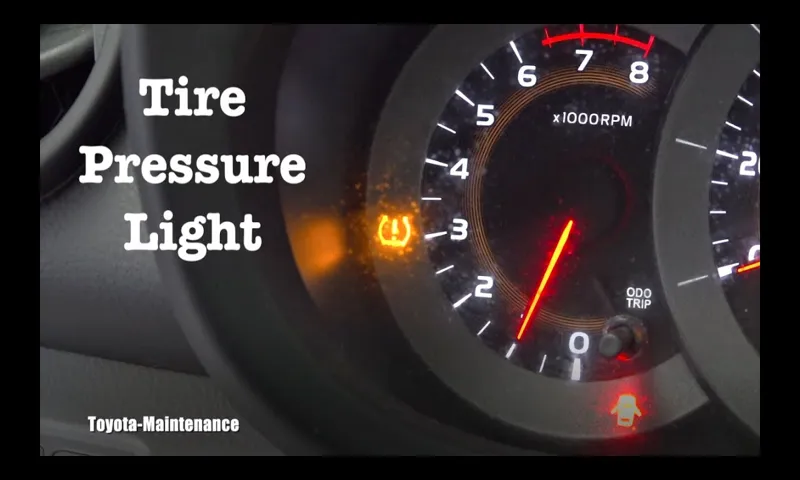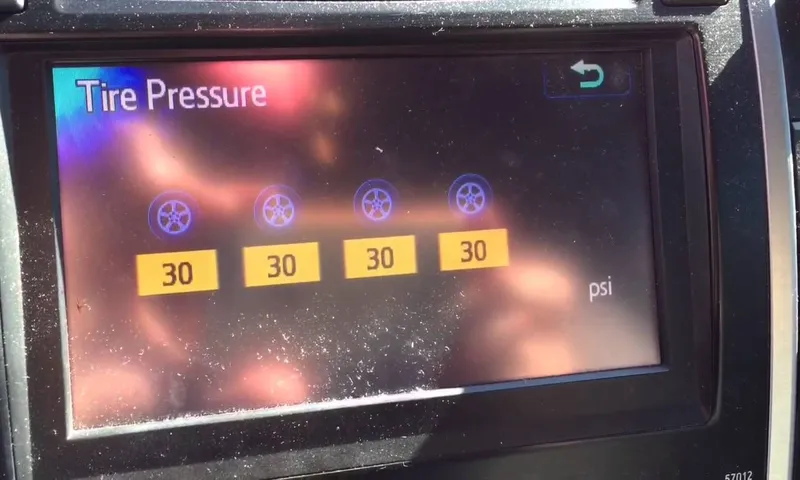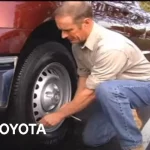Do you know how important it is to have the correct tire pressure on your Toyota Camry? Not only can it affect your fuel economy and performance, but it’s also a safety concern. In this blog post, we’ll guide you through the steps of how to check your tire pressure on your Toyota Camry. By the end of this read, you’ll know exactly what tools you need and how to get an accurate reading.
So, grab a cup of coffee and let’s dive in!
Table of Contents
Introduction
Checking tire pressure is an essential step in maintaining your Toyota Camry’s safety and performance. The recommended tire pressure for your vehicle can be found in the owner’s manual, but it’s important to check it regularly to ensure that it hasn’t dropped below the recommended level. If the pressure is too low, it can cause uneven tire wear, poor fuel economy, and even a blowout.
Fortunately, checking your tire pressure is a quick and easy process that can be done at home with just a few simple tools. All you need is a tire pressure gauge, which can be purchased at any auto parts store or online, and a source of compressed air, such as a gas station air pump. Simply remove the valve cap from each tire and press the gauge onto the valve stem to get a reading.
If the pressure is too low, use the air pump to add air until it reaches the recommended level. With regular checks and maintenance, you can ensure that your Toyota Camry’s tires are in top condition, providing you with a safe and reliable driving experience.
Why it’s Important to Check Tire Pressure
Tire pressure is a crucial aspect of car maintenance that often goes unnoticed. Many car owners don’t realize the importance of checking their tire pressure regularly, which can lead to various problems, including decreased fuel efficiency, tire wear, and even safety hazards. Your tires are the only point of contact between your car and the road, and if they’re not inflated correctly, it can affect your vehicle’s overall performance.
By keeping your tire pressure at the recommended level, you’ll not only extend the lifespan of your tires, but also ensure your car’s safety on the road. So, let’s dive into why it’s essential to check your tire pressure regularly.

When to Check Tire Pressure on Your Toyota Camry
As a Toyota Camry owner, it’s essential to keep an eye on your tire pressure. Proper tire pressure ensures that your vehicle runs smoothly and its fuel efficiency is optimized. You might be wondering how often you should check your tire pressure.
The answer to that depends on many factors such as how often you drive, the weather conditions, and the age of your tires. As a general rule, it’s recommended to check the tire pressure once every month and before you embark on a long road trip. This way, you can be assured that your vehicle’s tires are in good condition and free from any potential damages.
Moreover, when checking tire pressure, it’s essential to use a reliable tire pressure gauge and ensure that the tires are cold to get an accurate reading. Remember, maintaining proper tire pressure is vital in ensuring your safety and the longevity of your Toyota Camry.
Steps to Check Tire Pressure on Toyota Camry
Checking the tire pressure on your Toyota Camry is an essential part of keeping your vehicle safe and efficient. The first step is to gather the necessary tools: a tire pressure gauge and an air compressor. Begin by locating the tire pressure placard, which can typically be found on the driver’s side door jamb or inside the glove box.
This placard lists the recommended tire pressure levels for your specific Toyota Camry model. Next, remove the valve cap from each tire and press the gauge onto the valve stem. The gauge will provide you with a reading in PSI.
Compare this reading to the recommended levels on the placard and make any necessary adjustments using the air compressor. Remember to replace the valve caps when finished and check your tire pressure regularly, as changes in temperature and driving conditions can affect tire pressure. By ensuring your tire pressure levels are within the recommended range, you can improve your vehicle’s handling and fuel efficiency, as well as increase safety on the road.
Step 1: Gather the Right Tools
The first step in checking your Toyota Camry’s tire pressure is to gather the right tools. You’ll need a tire pressure gauge and a source of air, such as an air compressor or a gas station air pump. It’s important to make sure your tire pressure gauge is accurate, so you may want to invest in a quality gauge.
Once you have your tools, park your car on level ground and make sure the tires have had time to cool down. Check the recommended tire pressure for your Camry in the owner’s manual or on the tire placard located on the driver’s side doorjamb. Use the tire pressure gauge to measure the pressure of each tire and add or release air as needed to reach the recommended level.
Regularly checking and maintaining proper tire pressure can improve fuel efficiency, extend the life of your tires, and help keep you safe on the road.
Step 2: Locate the Tire Pressure Information
When it comes to maintaining your Toyota Camry, checking your tire pressure is one of the easiest and most important things you can do. Once you have your tire pressure gauge in hand, the next step is to locate the tire pressure information. This can typically be found on a sticker located on the driver’s side door jamb or in your owner’s manual.
The sticker will provide you with the recommended tire pressure for your specific make and model. It’s important to note that the recommended tire pressure may vary depending on the size of your tires and the weight of your vehicle. By locating and referencing this information, you can ensure that your tires are properly inflated and functioning at their best.
This will not only improve your handling and performance on the road, but it will also help prevent premature tire wear and potentially save you money on gas in the long run. So, take a few minutes to locate the tire pressure information for your Toyota Camry and get into the habit of checking your tire pressure regularly; your car (and your wallet) will thank you!
Step 3: Remove the Valve Cap and Use the Tire Pressure Gauge
When it comes to maintaining your Toyota Camry, checking the tire pressure is essential for safety and performance. Here are the steps to follow when checking tire pressure on your Camry: first, you’ll need a tire pressure gauge, which can be purchased at any auto parts store. Second, locate the valve stem on your tire and remove the valve cap.
The valve cap may be hand-tightened or have a small screwdriver slot. Next, firmly press the tire pressure gauge onto the valve stem. You’ll hear a hissing sound, which means the gauge is taking the measurement.
Continue holding the gauge on the valve stem until the hissing stops and the gauge shows a reading. The pressure should match the recommended level in your owner’s manual or on the inside of the driver’s door. If it’s too low, add air until the pressure reaches the correct level.
If it’s too high, release air by depressing the valve in the center of the valve stem with the tire gauge until it’s at the correct level. It’s important to remember to replace the valve cap when you’re finished, as it helps keep dirt and debris out of the valve stem. Regularly checking your tire pressure can increase fuel efficiency, extend the life of your tires, and ensure a safe and smooth ride for you and your passengers.
Step 4: Compare the Readings and Adjust if Necessary
When it comes to checking tire pressure on your Toyota Camry, it’s important to compare the readings and adjust if necessary. This is step four in the process and can help improve your vehicle’s performance and safety. After measuring the tire pressure using a gauge, compare the numbers to the recommended pressure levels in your car’s manual.
If the readings are too low or too high, adjust the pressure accordingly using a compressor or deflate the tire slightly if needed. Always make sure the readings are consistent across all four tires to ensure even wear and control. Properly inflated tires not only improve performance, but also increase fuel efficiency and extend the life of your tires.
So take the time to check your Toyota Camry’s tire pressure regularly and make any necessary adjustments for a smoother and safer ride.
Tips for Maintaining Correct Tire Pressure
One of the most important aspects of maintaining your Toyota Camry’s tires is ensuring that they have the correct tire pressure. Checking the tire pressure regularly can help ensure optimal safety and performance while driving. To check the tire pressure on a Toyota Camry, you can use a tire pressure gauge.
First, remove the valve cap and press the gauge onto the valve stem. Check the reading on the gauge and see if it matches the recommended pressure listed in the owner’s manual or on the tire itself. If the pressure is too low or too high, inflate or deflate the tire accordingly.
Remember to check the pressure in all four tires at least once a month and before long trips. By keeping your tires at the correct pressure, you can improve your gas mileage, extend your tire life, and maintain a smoother ride. So don’t neglect this important part of your Toyota Camry’s maintenance routine!
Tip 1: Check Tire Pressure Monthly and Before Long Trips
Maintaining the correct tire pressure is crucial for safe and efficient driving. One important tip for keeping your tires properly inflated is to check the pressure at least once a month and before heading out on long trips. Over time, tires tend to lose pressure due to natural leaks and changing temperatures.
Underinflated tires can negatively impact fuel efficiency and cause uneven tire wear, which can lead to expensive repairs and replacements down the line. On the other hand, overinflated tires can reduce stability and also cause uneven tire wear. Therefore, it is essential to maintain the correct tire pressure by using a tire pressure gauge and inflating the tires to the recommended PSI level.
This simple maintenance routine will not only lengthen the lifespan of your tires but also improve your overall vehicle’s safety and performance, making sure you arrive at your destination safely.
Tip 2: Keep Your Tires Properly Inflated
Maintaining proper tire pressure is crucial for ensuring your vehicle runs smoothly and efficiently. One of the easiest ways to do this is by checking your tire pressure regularly and inflating them to the recommended levels. The recommended tire pressure can be found in your vehicle owner’s manual or on the placard located inside the driver’s side door.
Overinflated tires can lead to a rough ride and increase the risk of a blowout, while underinflated tires can decrease fuel efficiency, wear unevenly, and jeopardize your safety on the road. Not to mention, tires that aren’t properly inflated are more likely to need replacing sooner, which can add up to significant expense over time. By maintaining the correct tire pressure, you’ll not only extend the life of your tires, but you’ll also save money on fuel costs and have a safer driving experience.
Regularly checking and inflating your tires is a small but important step in keeping your vehicle running smoothly. So, don’t forget to get out that tire pressure gauge!
Tip 3: Rotate Tires Regularly
Maintaining correct tire pressure is essential for ensuring your safety on the roads. Rotating your tires regularly is another crucial aspect of tire care that often goes overlooked. When you rotate your tires, you change their position, ensuring even wear and tear.
This can help you maximize their lifespan and save money in the long run. Tire rotation should be done every six months or 5,000-7,000 miles for optimal results. If left unchecked, uneven tire wear can lead to a bumpy ride, decreased handling, and even blowouts.
Rotating your tires is a simple process that doesn’t require any special tools. It involves moving your front tires to the rear, and vice versa. Doing this will help distribute the weight of your vehicle evenly, ensuring your tires wear out at the same rate.
When your tires wear evenly, they provide better traction on the road and decrease the likelihood of accidents. By rotating your tires regularly, you’ll keep yourself and other drivers safe while enjoying smoother rides and better fuel economy.
Conclusion
In conclusion, keeping your Toyota Camry’s tires properly inflated is as important as powering your car with fuel. While it may seem like a trivial task, checking your tire pressure can save you money on fuel and prolong the life of your tires. So, take a minute to grab a tire pressure gauge, locate your recommended tire pressure, and give your tires a quick check to ensure you’re spinning on the road with the right amount of air pressure.
Remember, maintaining proper tire pressure isn’t just a good idea, it’s a tire-riffic idea!”
FAQs
Why is it important to check tire pressure on a Toyota Camry?
Properly inflated tires ensure safety on the road, better fuel efficiency, and longer tire lifespan.
How often should I check the tire pressure on my Toyota Camry?
It is recommended to check your tire pressure at least once a month or before long drives.
How do I check the tire pressure on my Toyota Camry?
You can use a tire pressure gauge to check the pressure of each tire, which is typically located in the driver’s side door panel or in the owner’s manual.
What is the recommended tire pressure for a Toyota Camry?
The recommended tire pressure for a Toyota Camry can vary depending on the year and model. It is important to check the owner’s manual or the tire placard located in the driver’s side door panel for the correct tire pressure.
Can weather affect tire pressure on a Toyota Camry?
Yes, extreme temperatures, both hot and cold, can affect tire pressure. It is important to check tire pressure more frequently during these conditions and adjust accordingly.
What happens if I drive with low tire pressure on my Toyota Camry?
Driving with low tire pressure can cause poor handling, reduced fuel efficiency, and increased tire wear. It can also increase the risk of a tire blowout or other tire-related accidents.
Can tire pressure monitoring systems (TPMS) help me check tire pressure on my Toyota Camry?
Yes, TPMS can help you monitor your tire pressure and alert you when they are low. However, it is still recommended to manually check your tire pressure at least once a month.



